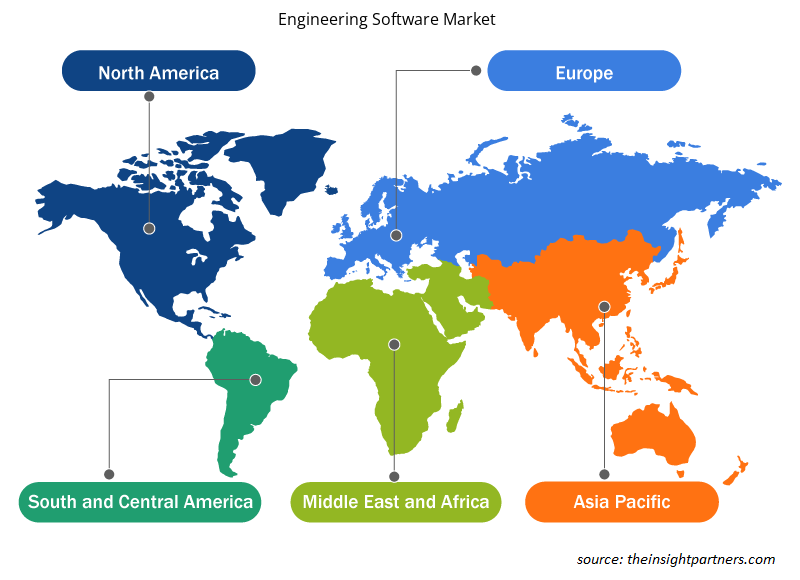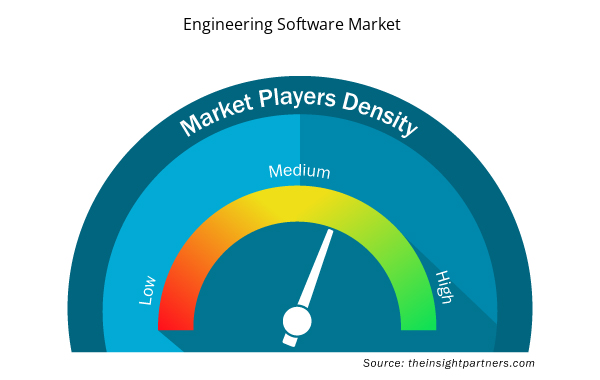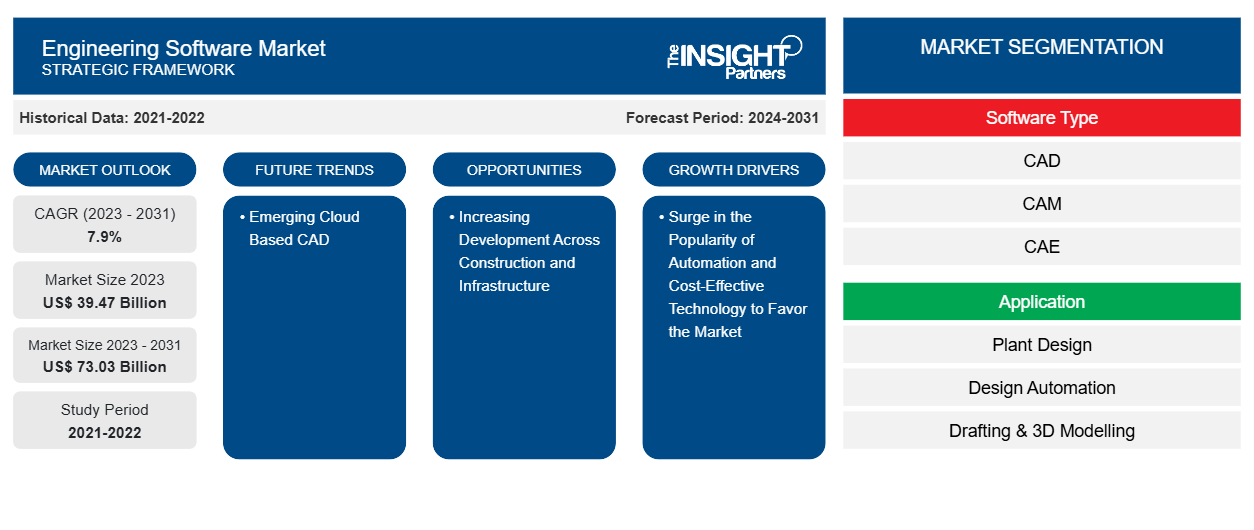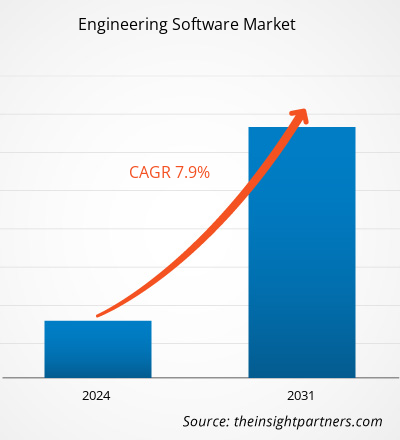エンジニアリング ソフトウェア市場の規模は、2023 年の 394.7 億米ドルから 2031 年には 730.3 億米ドルに達すると予測されています。市場は 2023 年から 2031 年にかけて 7.9% の CAGR を記録すると予想されています。自動化とコスト効率の高いテクノロジーの人気の高まりは、今後もエンジニアリング ソフトウェア市場の主要なトレンドであり続けると思われます。
エンジニアリングソフトウェア市場分析
自動車、航空宇宙、建設、医療などのさまざまな業界で CAD および CAE ソフトウェアの使用が増えていることが、市場の拡大につながっています。エンジニアリング用ソフトウェアには、コンピュータ支援設計 (CAD)、コンピュータ支援製造 (CAM)、コンピュータ支援エンジニアリング (CAE) などがあります。エンジニアリング ソフトウェア市場は、製品開発の時間と費用を短縮したいという企業からの需要の高まりなど、さまざまな理由から、予測期間を通じて大幅に拡大すると予想されています。
エンジニアリングソフトウェア市場の概要
エンジニア、設計者、製造業者は、エンジニアリング ソフトウェア ソリューションを利用して、重要なエンジニアリング ドキュメントの作成、製品のパフォーマンスと操作の分析とシミュレーション、複雑なモデルの開発を行うことができます。クラウドベースのソリューションでは、Web ブラウザーからアクセスできるため、チーム メンバーは任意のデバイスを使用してリモートで共同作業を行うことができます。その結果、企業は計算能力や有用性を犠牲にすることなく、ハードウェアの最新化と支出の削減が可能になります。
要件に合わせてレポートをカスタマイズする
このレポートの一部、国レベルの分析、Excelデータパックなど、あらゆるレポートを無料でカスタマイズできます。また、スタートアップや大学向けのお得なオファーや割引もご利用いただけます。
- このレポートの主要な市場動向を入手してください。この無料サンプルには、市場動向から見積もりや予測に至るまでのデータ分析が含まれます。
エンジニアリング ソフトウェア市場の推進要因と機会
自動化とコスト効率の高いテクノロジーの人気が高まり、市場が有利になります。
世界中のプラント 0/0 と EPC は、市場の競争が激化しているため、製造エラーと運用コストを削減するプレッシャーにさらされています。プラント エンジニアは、設計、製造、試運転のプロセス中に特定の国際標準に従うことで、品質を向上させることができます。製造と強度の問題は、設計ソフトウェア、継続的な分析、標準のアップグレードによって解決できます。その結果、世界中の企業が、建設と製造におけるミスを削減するために、エンジニアリング ソフトウェアをますます使用しています。
建設とインフラ全体の開発の拡大
どの国でも、社会経済の発展に貢献する主な要因の 1 つは建設であると考えられています。エチオピア、インド、中国、ブラジル、ウズベキスタン、カンボジア、タンザニア、ミャンマーなど、世界中の発展途上国では、建設業界が急速に拡大しています。これらの経済の基本的なインフラも急速に発展しています。たとえば、アジア太平洋および SAM の発展途上国では、インフラ開発に多くの外国直接投資が集まっています。これらの進歩はインフラの成長にも拍車をかけ、建設業界が拡大するにつれて、エンジニアリング ソフトウェアの必要性も高まります。したがって、インフラおよび建設ビジネス分野の進歩が拡大することが期待されます。
エンジニアリングソフトウェア市場レポートのセグメンテーション分析
エンジニアリング ソフトウェア市場分析の導出に貢献した主要なセグメントは、ソフトウェアの種類とアプリケーションです。
- ソフトウェアの種類に基づいて、エンジニアリング ソフトウェア市場は CAD、CAM、CAE、AEC、EDA に分かれています。CAD セグメントは予測期間中に成長すると予想されます。CAE, AEC, and EDA. The CAD segment is anticipated to grow in the forecast period.
- アプリケーション別に見ると、市場はプラント設計、設計自動化、製図と 3D モデリング、製品設計とテスト、その他に分類されます。設計自動化セグメントは予測期間中に成長すると予想されます。
地域別エンジニアリングソフトウェア市場シェア分析
エンジニアリング ソフトウェア市場レポートの地理的範囲は、主に北米、アジア太平洋、ヨーロッパ、中東およびアフリカ、南米/中南米の 5 つの地域に分かれています。北米はエンジニアリング ソフトウェア市場を支配してきました。北米地域のさまざまな業界でのハイテク採用の傾向が、エンジニアリング ソフトウェア市場の成長を後押ししています。デジタル ツールの採用の増加や政府機関による高額な技術支出などの要因が、北米のエンジニアリング ソフトウェア市場の成長を牽引すると予想されています。さらに、米国とカナダの先進国では研究開発に重点が置かれているため、北米のプレーヤーは技術的に高度なソリューションを市場に投入せざるを得ません。さらに、米国には、革新的なソリューションの開発にますます重点を置いているエンジニアリング ソフトウェア市場のプレーヤーが多数存在します。これらすべての要因が、この地域のエンジニアリング ソフトウェア市場の成長に貢献しています。
エンジニアリング ソフトウェア市場の地域別分析
予測期間を通じてエンジニアリング ソフトウェア市場に影響を与える地域的な傾向と要因は、Insight Partners のアナリストによって徹底的に説明されています。このセクションでは、北米、ヨーロッパ、アジア太平洋、中東およびアフリカ、南米および中米にわたるエンジニアリング ソフトウェア市場のセグメントと地理についても説明します。

- エンジニアリングソフトウェア市場の地域別データを入手
エンジニアリングソフトウェア市場レポートの範囲
| レポート属性 | 詳細 |
|---|---|
| 2023年の市場規模 | 394.7億米ドル |
| 2031年までの市場規模 | 730.3億米ドル |
| 世界のCAGR(2023年~2031年) | 7.9% |
| 履歴データ | 2021-2022 |
| 予測期間 | 2024-2031 |
| 対象セグメント | ソフトウェアタイプ別
|
| 対象地域と国 | 北米
|
| 市場リーダーと主要企業プロフィール |
|
エンジニアリング ソフトウェア市場のプレーヤー密度: ビジネス ダイナミクスへの影響を理解する
エンジニアリング ソフトウェア市場は、消費者の嗜好の変化、技術の進歩、製品の利点に対する認識の高まりなどの要因により、エンド ユーザーの需要が高まり、急速に成長しています。需要が高まるにつれて、企業は提供内容を拡大し、消費者のニーズを満たすために革新を起こし、新たなトレンドを活用し、市場の成長をさらに促進しています。
市場プレーヤー密度とは、特定の市場または業界内で活動している企業または会社の分布を指します。これは、特定の市場スペースに、その市場規模または総市場価値に対してどれだけの競合相手 (市場プレーヤー) が存在するかを示します。
エンジニアリング ソフトウェア市場で事業を展開している主要企業は次のとおりです。
- PTCC
- ロックウェル・オートメーション
- SAP SE
- シーメンス
- シノプシス株式会社
- オートデスク株式会社
免責事項:上記の企業は、特定の順序でランク付けされていません。

- エンジニアリングソフトウェア市場のトップキープレーヤーの概要を入手
エンジニアリング ソフトウェア市場のニュースと最近の動向
エンジニアリング ソフトウェア市場は、主要な企業出版物、協会データ、データベースなどの一次調査と二次調査後の定性的および定量的データを収集することによって評価されます。市場の動向の一覧は次のとおりです。
- 2024 年 2 月、世界的なテクノロジー企業 Cognizant は、プラットフォームの提供範囲を拡大することでビジネスの近代化を加速することを目指しています。同社は、ソフトウェア エンジニアリングの新時代を推進するために設計された生成 AI 対応プラットフォームである Cognizant Flowsource のリリースを発表しました。
(出典:コグニザント、プレスリリース、2024年)
- 2023 年 6 月、Nullspace, Inc. は、アラバマ州ハンツビルの老舗防衛請負業者である IERUS Technologies からのスピンオフとして設立されました。Nullspace, Inc. は、電磁気アプリケーション向けの高度なエンジニアリング ソフトウェアの提供に重点を置いています。
(出典:Nullspace、プレスリリース、2023年)
エンジニアリングソフトウェア市場レポートの対象範囲と成果物
「エンジニアリング ソフトウェア市場の規模と予測 (2021 ~ 2031 年)」レポートでは、以下の分野をカバーする市場の詳細な分析を提供しています。
- 対象範囲に含まれるすべての主要市場セグメントの世界、地域、国レベルでの市場規模と予測
- 市場の動向(推進要因、制約、主要な機会など)
- 今後の主な動向
- 詳細なPEST/ポーターの5つの力とSWOT分析
- 主要な市場動向、主要プレーヤー、規制、最近の市場動向を網羅した世界および地域の市場分析
- 市場集中、ヒートマップ分析、主要プレーヤー、最近の動向を網羅した業界の状況と競争分析
- 詳細な企業プロフィール
- 過去2年間の分析、基準年、CAGRによる予測(7年間)
- PEST分析とSWOT分析
- 市場規模価値/数量 - 世界、地域、国
- 業界と競争環境
- Excel データセット


- Electronic Health Record Market
- Drain Cleaning Equipment Market
- Medical Enzyme Technology Market
- Smart Locks Market
- Industrial Inkjet Printers Market
- Adaptive Traffic Control System Market
- Predictive Maintenance Market
- Hydrolyzed Collagen Market
- Trade Promotion Management Software Market
- Fishing Equipment Market

Report Coverage
Revenue forecast, Company Analysis, Industry landscape, Growth factors, and Trends

Segment Covered
This text is related
to segments covered.

Regional Scope
North America, Europe, Asia Pacific, Middle East & Africa, South & Central America

Country Scope
This text is related
to country scope.
よくある質問
The global Engineering Software market is expected to reach US$ 73.03 billion by 2031.
The key players holding majority shares in the global Engineering Software market are PTC, Rockwell Automation, Inc., SAP SE, Siemens, Synopsys, Inc., Autodesk Inc., AVEVA, and Dassault Systèmes.
Increasing development across construction and infrastructure is impacting engineering software, which is anticipated to play a significant role in the global engineering software market in the coming years.
The surge in the popularity of automation and cost-effective technology is the major factors that propel the global engineering software market growth.
The global engineering software market was estimated to be US$ 39.47 billion in 2023 and is expected to grow at a CAGR of 7.9% during the forecast period 2024 - 2031.
Trends and growth analysis reports related to Technology, Media and Telecommunications : READ MORE..
The Insight Partners performs research in 4 major stages: Data Collection & Secondary Research, Primary Research, Data Analysis and Data Triangulation & Final Review.
- Data Collection and Secondary Research:
As a market research and consulting firm operating from a decade, we have published and advised several client across the globe. First step for any study will start with an assessment of currently available data and insights from existing reports. Further, historical and current market information is collected from Investor Presentations, Annual Reports, SEC Filings, etc., and other information related to company’s performance and market positioning are gathered from Paid Databases (Factiva, Hoovers, and Reuters) and various other publications available in public domain.
Several associations trade associates, technical forums, institutes, societies and organization are accessed to gain technical as well as market related insights through their publications such as research papers, blogs and press releases related to the studies are referred to get cues about the market. Further, white papers, journals, magazines, and other news articles published in last 3 years are scrutinized and analyzed to understand the current market trends.
- Primary Research:
The primarily interview analysis comprise of data obtained from industry participants interview and answers to survey questions gathered by in-house primary team.
For primary research, interviews are conducted with industry experts/CEOs/Marketing Managers/VPs/Subject Matter Experts from both demand and supply side to get a 360-degree view of the market. The primary team conducts several interviews based on the complexity of the markets to understand the various market trends and dynamics which makes research more credible and precise.
A typical research interview fulfils the following functions:
- Provides first-hand information on the market size, market trends, growth trends, competitive landscape, and outlook
- Validates and strengthens in-house secondary research findings
- Develops the analysis team’s expertise and market understanding
Primary research involves email interactions and telephone interviews for each market, category, segment, and sub-segment across geographies. The participants who typically take part in such a process include, but are not limited to:
- Industry participants: VPs, business development managers, market intelligence managers and national sales managers
- Outside experts: Valuation experts, research analysts and key opinion leaders specializing in the electronics and semiconductor industry.
Below is the breakup of our primary respondents by company, designation, and region:

Once we receive the confirmation from primary research sources or primary respondents, we finalize the base year market estimation and forecast the data as per the macroeconomic and microeconomic factors assessed during data collection.
- Data Analysis:
Once data is validated through both secondary as well as primary respondents, we finalize the market estimations by hypothesis formulation and factor analysis at regional and country level.
- Macro-Economic Factor Analysis:
We analyse macroeconomic indicators such the gross domestic product (GDP), increase in the demand for goods and services across industries, technological advancement, regional economic growth, governmental policies, the influence of COVID-19, PEST analysis, and other aspects. This analysis aids in setting benchmarks for various nations/regions and approximating market splits. Additionally, the general trend of the aforementioned components aid in determining the market's development possibilities.
- Country Level Data:
Various factors that are especially aligned to the country are taken into account to determine the market size for a certain area and country, including the presence of vendors, such as headquarters and offices, the country's GDP, demand patterns, and industry growth. To comprehend the market dynamics for the nation, a number of growth variables, inhibitors, application areas, and current market trends are researched. The aforementioned elements aid in determining the country's overall market's growth potential.
- Company Profile:
The “Table of Contents” is formulated by listing and analyzing more than 25 - 30 companies operating in the market ecosystem across geographies. However, we profile only 10 companies as a standard practice in our syndicate reports. These 10 companies comprise leading, emerging, and regional players. Nonetheless, our analysis is not restricted to the 10 listed companies, we also analyze other companies present in the market to develop a holistic view and understand the prevailing trends. The “Company Profiles” section in the report covers key facts, business description, products & services, financial information, SWOT analysis, and key developments. The financial information presented is extracted from the annual reports and official documents of the publicly listed companies. Upon collecting the information for the sections of respective companies, we verify them via various primary sources and then compile the data in respective company profiles. The company level information helps us in deriving the base number as well as in forecasting the market size.
- Developing Base Number:
Aggregation of sales statistics (2020-2022) and macro-economic factor, and other secondary and primary research insights are utilized to arrive at base number and related market shares for 2022. The data gaps are identified in this step and relevant market data is analyzed, collected from paid primary interviews or databases. On finalizing the base year market size, forecasts are developed on the basis of macro-economic, industry and market growth factors and company level analysis.
- Data Triangulation and Final Review:
The market findings and base year market size calculations are validated from supply as well as demand side. Demand side validations are based on macro-economic factor analysis and benchmarks for respective regions and countries. In case of supply side validations, revenues of major companies are estimated (in case not available) based on industry benchmark, approximate number of employees, product portfolio, and primary interviews revenues are gathered. Further revenue from target product/service segment is assessed to avoid overshooting of market statistics. In case of heavy deviations between supply and demand side values, all thes steps are repeated to achieve synchronization.
We follow an iterative model, wherein we share our research findings with Subject Matter Experts (SME’s) and Key Opinion Leaders (KOLs) until consensus view of the market is not formulated – this model negates any drastic deviation in the opinions of experts. Only validated and universally acceptable research findings are quoted in our reports.
We have important check points that we use to validate our research findings – which we call – data triangulation, where we validate the information, we generate from secondary sources with primary interviews and then we re-validate with our internal data bases and Subject matter experts. This comprehensive model enables us to deliver high quality, reliable data in shortest possible time.


 このレポートの無料サンプルを入手する
このレポートの無料サンプルを入手する